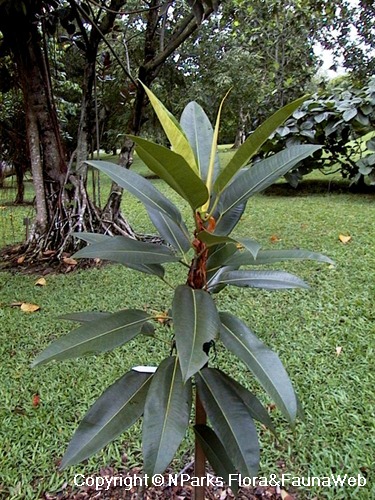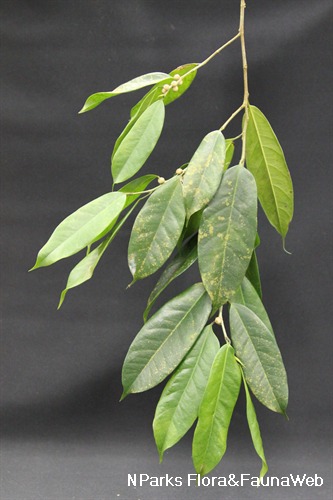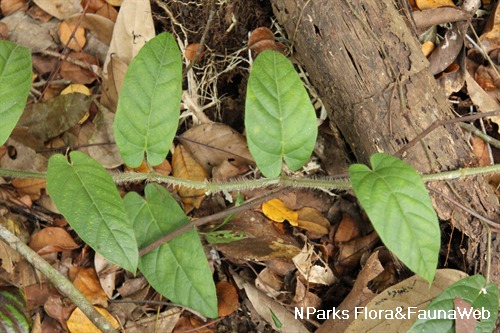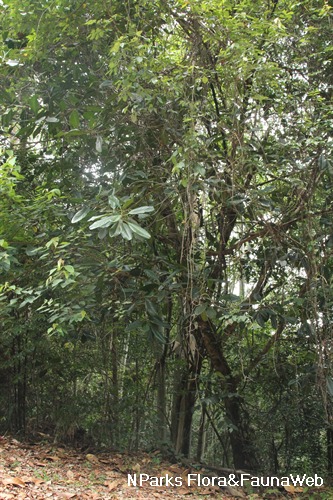
Back
Ficus pleurocarpa F.Muell.
| Family Name: | Moraceae |
| Synonyms: | Ficus cylindrica Warb. |
| Common Name: | Banana Fig |
Name
Classifications and Characteristics
| Plant Division | Angiosperms (Flowering Seed Plants) (Dicotyledon) |
|---|---|
| Plant Growth Form | Tree |
| Lifespan (in Singapore) | Perennial |
| Mode of Nutrition | Autotrophic |
| Maximum Height | 30 m |
Biogeography
| Native Distribution | Australia |
|---|---|
| Native Habitat | Terrestrial |
| Preferred Climate Zone | Tropical |
| Local Conservation Status | Non-native |
Description and Ethnobotany
| Growth Form | A medium or big sized tree up to 30 m tall. |
|---|---|
| Foliage | Leaves are thick and leathery, oblong to ovate, 15-25 cm long and 5-10 cm wide. Upperside of the leaf (adaxial surface) is dark-green, while the underside (abaxial surface) is paler green and rusty dotted. The primary vein and the two lateral veins at the base of the leaf are very prominent, while the other parallel lateral veins are less visible. Leaf stipules are long, measuring 10-30 cm in length. |
| Stems | Stems are hairy. |
| Flowers | This tree is monoecious (male and female flowers on the same plant). |
| Fruit | Banana figs are cylindrical, measuring 3.5-6.5 cm long and 1.3-3 cm wide. The fruits are borne in pairs, turning from green to orange or red when ripe. |
| Habitat | Wet tropical forests up to 1,000 m altitude. |
| Associated Fauna | This plant is pollinated by two species of fig wasp, Pleistodontes regalis and P. deuterus. |
| Etymology | The specific epithet pleurocarpa means ribbed fruit in Greek. |
| Ethnobotanical Uses | Edible Plant Parts : Edible Fruits Food (Fruit or Vegetable): Fruits can be eaten fresh or dried. |
Landscaping Features
| Desirable Plant Features | Ornamental Foliage, Ornamental Fruits |
|---|---|
| Landscape Uses | Parks & Gardens |
Fauna, Pollination and Dispersal
| Fauna Pollination Dispersal Associated Fauna | Bird-Attracting (Fruits), Bat Food |
|---|---|
| Pollination Method(s) | Biotic (Fauna) (Associated with: Pleistodontes regalis, Pleistodontes deuterus) |
| Seed or Spore Dispersal | Biotic (Fauna) (Vertebrates (Bat), Vertebrates (Other Mammal)) |
Plant Care and Propagation
| Light Preference | Full Sun, Semi-Shade |
|---|---|
| Water Preference | Moderate Water |
| Plant Growth Rate | Moderate |
| Rootzone Tolerance | Moist Soils, Well-Drained Soils, Fertile Loamy Soils |
| Propagation Method | Seed |
Foliar
| Foliage Retention | Evergreen |
|---|---|
| Mature Foliage Colour(s) | Green |
| Foliar Type | Simple / Unifoliate |
| Leaf Area Index (LAI) for Green Plot Ratio | 3.0 (Tree - Intermediate Canopy) |
Floral (Angiosperm)
| Flower & Plant Sexuality | Unisexual Flowers |
Fruit, Seed and Spore
| Mature Fruit Colour(s) | Orange, Red |
|---|
Image Repository
Others
| Master ID | 1621 |
|---|---|
| Species ID | 2914 |
| Flora Disclaimer | The information in this website has been compiled from reliable sources, such as reference works on medicinal plants. It is not a substitute for medical advice or treatment and NParks does not purport to provide any medical advice. Readers should always consult his/her physician before using or consuming a plant for medicinal purposes. |




.jpg)